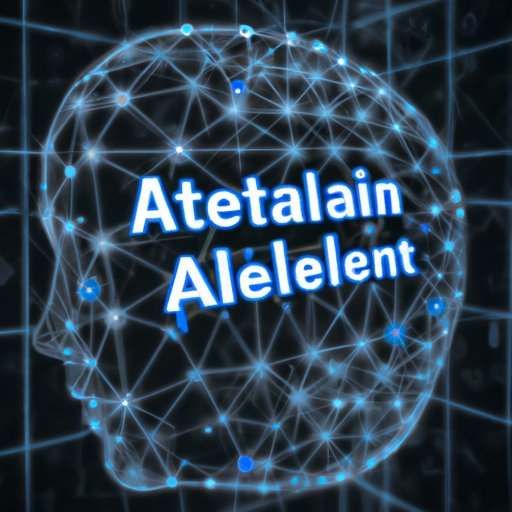Introduction
Artificial intelligence (AI) is a rapidly growing field with immense potential. An AI algorithm is a set of instructions designed to teach a computer system how to learn from and respond to data. By developing algorithms, AI systems can be trained to recognize patterns, make decisions, and solve complex problems. This article provides a comprehensive guide on how to create an AI algorithm.
Breaking Down the Steps of Creating an AI Algorithm
Creating an AI algorithm involves several distinct steps. These include identifying the problem, designing the algorithm, implementing the algorithm, testing and refining the algorithm, and deploying it into a production environment.
Identifying the Problem
The first step in creating an AI algorithm is to identify the problem that needs to be solved. AI algorithms are used to solve a wide range of problems, from recognizing images to predicting stock prices. By understanding the problem, you can determine which type of algorithm will be most effective for the task.
Designing the Algorithm
Once the problem has been identified, the next step is to design the algorithm. This involves selecting the appropriate data structure, selecting the appropriate programming language, and designing the logic of the algorithm. At this stage, it is important to consider scalability, performance, and accuracy.
Implementing the Algorithm
The third step is to implement the algorithm. This involves writing code to transform the algorithm into executable form. Depending on the complexity of the algorithm, this could involve writing hundreds or thousands of lines of code.
Testing and Refining the Algorithm
The fourth step is to test and refine the algorithm. This involves running the algorithm on sample data to ensure that it performs as expected. The algorithm should then be refined based on the results of the tests. This process should be repeated until the desired level of accuracy is achieved.
Deploying the Algorithm
The final step is to deploy the algorithm into a production environment. This involves integrating the algorithm into an existing system or building a new system from scratch. Once deployed, the system should be monitored and tested regularly to ensure that it continues to perform as expected.
Pros and Cons of AI Algorithms
AI algorithms have both advantages and disadvantages. According to a study by McKinsey Global Institute, “AI-enabled automation could add $13 trillion to global GDP by 2030.” On the other hand, AI algorithms can be difficult to design, implement, and maintain, and they can also lead to ethical issues if not managed properly.
Advantages
The main advantages of AI algorithms include increased accuracy and efficiency, reduced costs, improved decision making, and enhanced customer experience. AI algorithms can also help reduce human error, improve safety, and increase productivity.
Disadvantages
The main disadvantages of AI algorithms include high development costs, long implementation times, and difficulty in keeping up with changing technologies. Additionally, AI algorithms can lack transparency and can lead to ethical issues if not managed properly.
Comparing Different Algorithms and Their Applications
AI algorithms can be divided into three main types: supervised learning, unsupervised learning, and reinforcement learning. Each type of algorithm has its own unique applications and benefits.
Supervised Learning
Supervised learning algorithms use labeled datasets to learn from and make predictions. Examples of supervised learning algorithms include linear regression and logistic regression. Supervised learning is often used for tasks such as image recognition, sentiment analysis, and forecasting.
Unsupervised Learning
Unsupervised learning algorithms use unlabeled datasets to learn from and make predictions. Examples of unsupervised learning algorithms include clustering and anomaly detection. Unsupervised learning is often used for tasks such as recommendation engines and fraud detection.
Reinforcement Learning
Reinforcement learning algorithms use trial and error to learn from and make decisions. Examples of reinforcement learning algorithms include Q-learning and Deep Q-learning. Reinforcement learning is often used for tasks such as playing video games and controlling robots.

Examining the Current State of AI Technology
AI technology is rapidly evolving. There are now numerous machine learning platforms available that make it easier to develop and deploy AI algorithms. Additionally, AI algorithms are being used in a wide range of applications, from healthcare to finance.
Machine Learning Platforms
There are many machine learning platforms available today, such as Amazon Web Services, Google Cloud Platform, and Microsoft Azure. These platforms provide powerful tools and services that make it easier to develop and deploy AI algorithms.
AI Applications
AI algorithms are being used in a wide range of applications, from autonomous vehicles to medical diagnosis. AI algorithms are being used to automate processes, improve decision making, and enhance customer experience.

Demonstrating How to Use Existing Open Source AI Tools
In addition to commercial machine learning platforms, there are also numerous open source AI tools available. These tools can be used to quickly develop and deploy AI algorithms. Some of the most popular open source AI tools include TensorFlow, Keras, and PyTorch.
TensorFlow
TensorFlow is an open source library for numerical computation and machine learning. It provides powerful tools for building and training neural networks, and can be used to develop a wide range of AI algorithms.
Keras
Keras is an open source library for deep learning. It provides easy-to-use APIs for building and training neural networks, and is used for a wide range of tasks, from image classification to natural language processing.
PyTorch
PyTorch is an open source library for deep learning. It provides powerful tools for building and training neural networks, and is used for a wide range of tasks, from computer vision to natural language processing.

Exploring the Potential Future of AI Algorithms
The potential future of AI algorithms is bright. AI algorithms are becoming increasingly sophisticated and are being used in a wide range of applications. In the future, AI algorithms could lead to increased automation, improved efficiency, and enhanced security.
Increased Automation
AI algorithms could lead to increased automation in many industries. AI algorithms can be used to automate mundane tasks, freeing up employees to focus on more complex work. This could lead to increased productivity and cost savings.
Improved Efficiency
AI algorithms could also lead to improved efficiency. AI algorithms can be used to optimize processes and make decisions faster than ever before. This could lead to increased productivity and cost savings.
Enhanced Security
Finally, AI algorithms could lead to enhanced security. AI algorithms can be used to detect and prevent security threats, protecting sensitive data from malicious actors.
Conclusion
Creating an AI algorithm is an involved process that requires a deep understanding of both AI and software engineering. By following the steps outlined in this article, you can create an AI algorithm that is capable of solving complex problems and producing accurate results. As AI technology continues to evolve, the possibilities for AI algorithms are limitless.
(Note: Is this article not meeting your expectations? Do you have knowledge or insights to share? Unlock new opportunities and expand your reach by joining our authors team. Click Registration to join us and share your expertise with our readers.)
